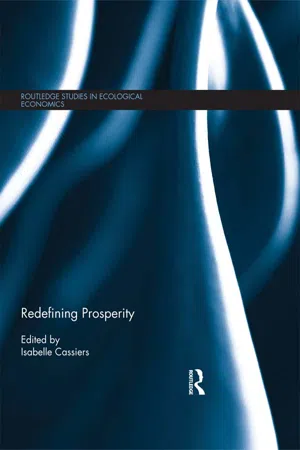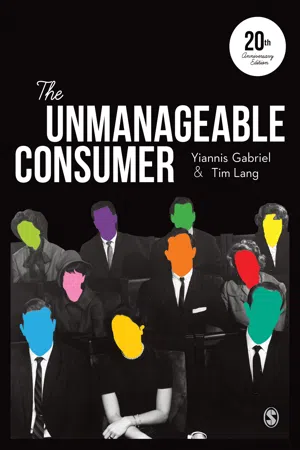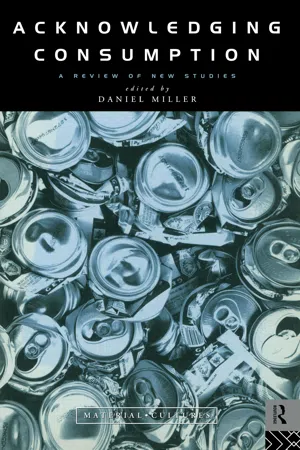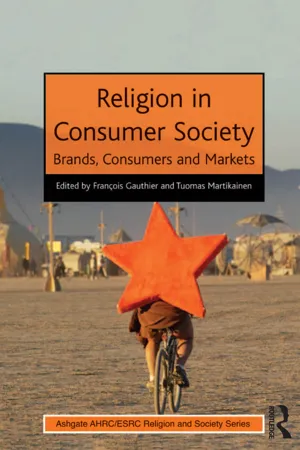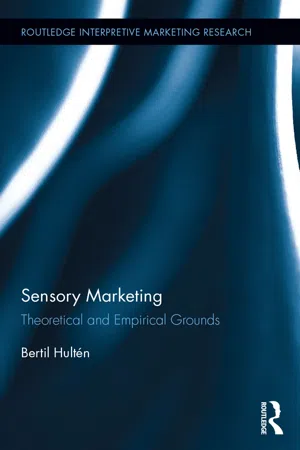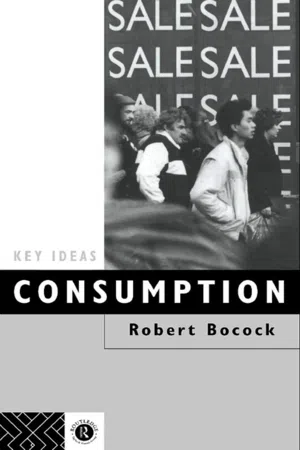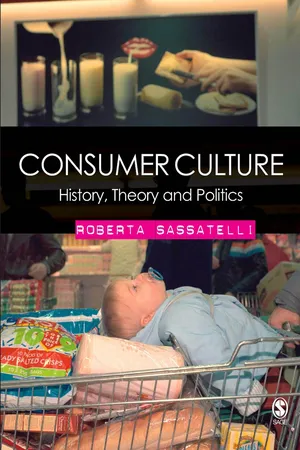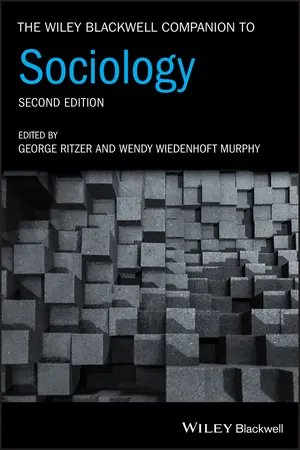History
Consumerism
Consumerism refers to the social and economic ideology that encourages the acquisition of goods and services in ever-increasing amounts. It gained prominence in the 20th century, particularly in Western societies, as mass production and advertising fueled a culture of materialism and consumption. Consumerism has had a significant impact on the global economy, shaping patterns of production, consumption, and waste.
Written by Perlego with AI-assistance
Related key terms
Related key terms
1 of 4
Related key terms
1 of 3
11 Key excerpts on "Consumerism"
- eBook - ePub
- Isabelle Cassiers, Isabelle Cassiers(Authors)
- 2014(Publication Date)
- Routledge(Publisher)
The word “Consumerism” designates a way of life; norms and standards for legitimate desire and for a successful life; and a means of transmitting messages, goods, and services. These cultural aspects of Consumerism may vary through time and space. Broadly speaking, however, it is possible to point out several invariable characteristics which return, omnipresent and insistent, in most descriptions of the phenomenon: an individualist mode of consumption that is dependent on the market, quantitatively insatiable, invasive, hedonistic, focused on novelty, using signs rather than things, and prodigal in its use of natural and human resources. Baudrillard (1970) may be credited with drawing attention to this cultural dimension of developed capitalist societies. Second, Consumerism is a mode of consumption that is both historically dated and geographically located. It has no equivalent in past human societies. It has existed as a mode of consumption within developed capitalist societies since the 1920s. It became rampant following the Second World War and the emergence of the Keynesian state, which was entirely focused on what was then called the policy of demand. Consumerism survived the dismantling of Keynesian policies at the close of the 1970s, and continues to underpin policy in the post-Ford era. Though anchored in the West, it is spreading ever more rapidly to developing Southern-hemisphere countries, and in particular to so-called “emerging economies”. 2 Three critical approaches to Consumerism The critique of Consumerism has existed since the birth of consumer society. It is a complex critique, and is itself part of the much broader critique of capitalism - eBook - ePub
Core Values in American Life
Living with Contradictions
- Arthur Neal(Author)
- 2017(Publication Date)
- Routledge(Publisher)
6Consumerism
The development of Consumerism stems from the emergence of materialism, hedonism, and sensate values among all major sectors of modern society. In 1899, Thorstein Veblen (1994) saw Consumerism as the defining characteristic of modern society. From his vantage point, society was divided into a series of power blocs, each motivated by materialistic values and each seeking to promote inequality in their own favor. Further, with the increased anonymity of modern life, the scope of individual respectability does not extend very far. Most of the people encountered on a daily basis are strangers, and a conspicuous display of wealth becomes one way of externalizing social worth and providing emblems of social significance. Thus, it is not the ownership of wealth that conveys social status, but the symbolic expression of a capacity to spend, to buy, or to otherwise engage in consumer-oriented behavior.The ascendance of advertising was a central component in the cultural transformation of the economic system (Lears, 1995). Business organizations recognized that their success was dependent on more than the organization of production. The rise of modern advertising depended on selling more goods at a faster rate (Fowles, 1996). As businesses grew in size, the consumers of their products became more impersonal. It became important to differentiate their product from that of their competitors.Technological advancements in the media of communication had opened up new possibilities for the dissemination of consumer information and persuasive appeals (Bogart, 2000). If millions of people were exposed to a commercial, it did not take a very large response rate for the advertisement to be successful. If only a small percent responded in a favorable way, the objective of the advertising campaign could be reached or exceeded. - eBook - ePub
- Yiannis Gabriel, Tim Lang(Authors)
- 2015(Publication Date)
- SAGE Publications Ltd(Publisher)
Like the words consumption and consumer, the word Consumerism has emerged as the umbrella term that captures the centrality of consumption in life. It has become part of the vocabulary of different intellectual traditions which carry different nuances but share the conviction that consumption provides the key to understanding of a wide range of issues in economics, psychology, cultural studies and politics. At its heart, Consumerism is an ideology on a par with religion and politics – even overtaking them on some fronts. It looks at consumption as the source of meaning, identity and pleasure. Unlike politics and religion, Consumerism is based on a relatively narrow conception of self-interest and personal choice. As a moral doctrine, therefore, it overcomes the Puritan ethic of self-denial; it celebrates and emphasizes the right of each person to search and find happiness in the use and display of commodities that they freely choose and acquire. Consumption has emerged virtually unchallenged as the essence of the good life and the vehicle for freedom, power and happiness. The claims of style, taste, fantasy and sexuality are at the forefront of this ideology, in which gender makes an intermittent appearance and class can vanish.As an economic ideology, Consumerism is seen as the force fuelling technological innovation and disseminating it globally. Following the collapse in the 1990s of the Communist bloc and its productionist rhetoric (‘forever more tons of steel per head’), Consumerism emerged uncontested as the ideological force behind the hegemony of free markets. It championed the pursuit of ever-higher standards of living from ever-less regulated markets, ushering in a new period of capitalist accumulation. It has become a key feature of international relations from trade and aid to foreign policy. The rise of the consumer and, relatedly, free markets are seen as the key to economic development everywhere.Consumerism has long been the hallmark of neo-liberal politics but it has been increasingly embraced across the political spectrum in high-, medium- and low-income countries alike. The modern state has emerged as a guarantor of consumer rights and minimum standards while facilitating the ‘free’ operation of markets. In this process, large sections of the state itself – including the provision of health and education services – come under the sway of market forces; indeed, they are turned into quasi-markets. Almost all political parties have adapted accordingly, shifting their rhetoric from paternalism and protection to choice and freedom. Consumerism is the guarantor of access to marketplaces that supply glamorous, stylish goods and personalized services in contrast to the shabby, run-down state services left over from a previous political era. In this new world, the role of the state is to create and defend markets and to ensure fair market disciplines are applied. - eBook - ePub
- Daniel Miller(Author)
- 2005(Publication Date)
- Routledge(Publisher)
5 CONSUMPTION WITHIN HISTORICAL STUDIES
Paul Glennie
IThe significance of consumption for history
INTRODUCTION AND BACKGROUND
Earlier this century, industrial and agricultural revolutions were being discovered almost everywhere that historians looked. Recently it has been consumer revolutions, at least among European and American historians (little literature has hitherto addressed other histories of consumption, though see Clunas 1991). Phrases like the birth of consumer society, emergent modern consumption, the rise of mass consumption, and the rise of mass market culture have been applied to the sixteenth and early seventeenth centuries (Thirsk 1978); Restoration England (Earle 1989: Shammas 1990; Weatherill 1988); the early eighteenth century (Eversley 1967); the Georgian period (Campbell 1987; McKendrick, Brewer and Plumb 1982; Williams 1987); the late nineteenth century (Fox and Lears 1983; Fraser 1981; Lee 1981); and between the two World Wars (Miller 1991). And, of course, each account raises questions about defining ‘consumer society’, and about consumption’s connections to wider economic and cultural changes.This proliferation reflects both continuous growth in Western consumption, and historians’ various definitions of ‘consumer society’. In addition, work on consumption is characterised by fragmentation, with very many local case-studies. Most general treatments of consumption either cover short periods and a single country, or take a long-run comparative view only for certain goods. The sheer variety of available sources (artefactual, documentary, visual, literary), and the divergent agendas of specialised research fields in different countries, exacerbate diversity and fragmentation. Different histories inform, and are informed by, highly divergent general analyses on consumption, and many historians distrust explicit theorising as a comparative and synthesising device. - eBook - ePub
Religion in Consumer Society
Brands, Consumers and Markets
- François Gauthier, Tuomas Martikainen, Tuomas Martikainen(Authors)
- 2016(Publication Date)
- Routledge(Publisher)
telos of simulacra, reification, or disenchantment which are supposedly inherent to merchandise, as ‘critical theory’ and the rationalisation thesis would argue. Rather, consumption rapidly developed as an all-encompassing cultural ethos because consumer objects were the new ways through which the modern culture of individualism could find an expression.55 Charles Taylor, Varieties of Religion Today: William James Revisited (London and New York, 2002), 79–80.If the cultural revolution of Consumerism is a step further into individualism, approaching the issue from the standpoint of a radicalisation of the authenticity and expressivity tropes highlights its social moorings and cultural dynamics. It does not isolate the individual and her choices from social determinations and cultural processes and values, while showing how the exercise of choice is constitutive of subjectivity today – how ‘free choice’ is a social imperative. The resulting individualism is consequently not narcissism, as the expression of one’s identity supposes the constant (real or virtual) presence of others to ensure recognition. The web of signs and meanings that makes up our consumer and media culture is the background that gives meaning to our actions. As Taylor illustrates with the example of fashion, Consumerism is a general social structure in which the collective is not oriented towards a common action and a shared destiny but rather takes the form of an arena for mutual exposition. Consumer culture is therefore paradoxically one which is as intensely individualistic as it is one in which social relations and collective experiences, be it in intimate circles or massive gatherings, are of paramount importance.Consumerism and Religion Today
From our perspective, Consumerism appears to be far from superficial: it is bound to the very founding and directing principles of modern culture. The primacy of authenticity that it carries has profoundly affected even the most institutionalised and traditional of religions, by questioning the authority mechanisms that concretely ensured their competence regarding Truth.56 Experience – of one’s own, tested in exchange with trusted others including charismatic figures – has superseded tradition (in Weber’s sense) as the measure and means of Truth. This process tends to value emotion over reason, hence the increasing appeal to the emotions across the religious spectrum, from holistic spiritualities to charismatic trends, Pentecostalism, and certain types of fundamentalisms. The rise of emotional religiosities is consequently not the lightened expression of some postmodern trend. It is ‘one of the results of a long process by which Moderns have learned to think of themselves as beings endowed with interiority and to think of their presence in the world no longer with respect to an order inscribed in the nature of things or willed by God, but as a quest for happiness and wellbeing’.57 - eBook - ePub
- Tony Blackshaw(Author)
- 2005(Publication Date)
- Routledge(Publisher)
5Consumerism as the Liquid Modern Way of Life
If our ancestors were shaped and trained by their societies as producers first and foremost, we are increasingly shaped and trained as consumers first, and all the rest after.Zygmunt Bauman1In the Sage Dictionary of Cultural Studies, Chris Barker’s first definition of consumption simply suggests that to consume is ‘to use or ingest’.2 Without actually saying so, Barker goes on to add that the process of consuming is better understood as Consumerism because this second concept recognizes the economic and cultural dimensions that underpin the different uses to which the commodities that circulate in capitalist societies are put. In this regard and in keeping with most other interpretations of Consumerism in cultural studies,3 he suggests that consumers do not merely consume commodities like unsuspecting dupes (or dopes), but they ‘generate their own meanings through the interplay of commodities and [their own] cultural competencies’.It must be noted that what is missing from Barker’s definition is any recognition of the culture of excess associated with Consumerism which in its oversupply leaves innumerable endings, untied and messy–wasted lives as well as wasted commodities. It is conspicuous too that in Barker’s definition Consumerism is not understood as an all-encompassing reality–it appears instead as a powerful belief system but one that can be transgressed or resisted because there are other alternative belief systems that vie for people’s attention in latter-day capitalist societies. In this sense, Barker plays down Bauman’s argument that today we are all ‘consumers in a consumers’ society. Consumer society is a market society; we are all in and on the market, simultaneously customers and commodities’.4 - eBook - ePub
Sensory Marketing
Theoretical and Empirical Grounds
- Bertil Hultén(Author)
- 2015(Publication Date)
- Routledge(Publisher)
Generally, consumption has been thought to contribute to economic, social, and cultural changes in a society’s development, which I will return to. Furthermore, it is believed that consumption fulfills a number of important social functions, where consumption in terms of demand, from an economic perspective, is believed to stimulate economic growth and affects a country’s GDP. In this context, consumption, both nationally and individually, can be regarded as signs of success and prosperity.Another influence relates to consumers from a sociological perspective, regarding what they consume as types of goods and services, which directly affects different individuals’ quality of life and lifestyles. Both individual consumption and group consumption therefore are considered to have been one of the most important ways for many individuals to create an image of themselves, of others, and of society itself, to achieve the creation of identity and self-realization.It is also considered, from a cultural perspective, that consumption is a form of collection of objects, because many people collect the artifacts that constitute the very foundation of a social culture. Hereby, consumption contributes in different ways to change both the societal culture and various sub-cultures, which was not the case earlier.Consumer Culture Theory
In the 1980s, a consumer culture theory (CCT) developed in the United States, which was an approach to understanding consumer behavior, and not just buying behavior; and it had its first theoretical starting points in terms such as aesthetics and symbolism, as well as semiotics. Among the concepts and themes that came to be introduced were the value of structuralism, symbolic interactionism, semiotic perspective, critical macro perspective, and cultural, anthropological approaches. Different methods for the interpretation of consumers’ behaviors with respect to the texts were developed, and there was an emphasis on the content and meaning of symbolism, with respect to both goods and advertisements in the form of communication in marketing.Thereafter, in the 1990s, there formed a number of European research specializations within consumer culture theory in Denmark, France, Italy, and the United Kingdom, where British scientists developed a highly critical tradition in marketing. The Danish focus was culturally influenced, and it early on came to focus on understanding cultural differences in communication to consumers in different cultures. Among the French researchers, the interpretations of consumer behavior and studies of consumption experiences were in focus, along with the postmodernist idea, which I will return to. Furthermore, the French sociological research tradition played an important role by contributing to an approach that had a critical view of marketing. - eBook - ePub
- John Storey(Author)
- 2017(Publication Date)
- Routledge(Publisher)
Production thus produces not only the object but also the manner of consumption, not only objectively but also subjectively. Production thus creates the consumer (1973: 92). Our contemporary attitudes to consumption, our consumption practices and our consumption desires, have developed alongside the historical development of capitalism as a mode of production. Put simply, Consumerism is the capitalist version of consumption; it is a particular historical mode of consumption unique to this mode of production. Consumerism is not, therefore, just consumption, it is increasingly a way of life, producing a sense – what Gramsci would call a ‘common sense’ (1971) – that who we are is defined and expressed through the commodities we consume. Consumerism is a practice that seeks to define people first and foremost as consumers. Moreover, it is a way of life that is dependent on more of the same – i.e. more capitalism. 1 One of the things that makes consumption under capitalism different is that the vast majority of what we consume has been produced as commodities to be sold for profit. Consumerism depends on a world of things. As Marx explains in the opening sentence of volume one of Capital, ‘The wealth of societies in which the capitalist mode of production prevails appears as an immense collection of commodities’ (Marx 1976: 127). Commodities have three features: ‘exchange value’, ‘use value’, and ‘value.’ Exchange value is the price a commodity can secure in the marketplace. In order to achieve this it must have a use value (i.e. be of some use to someone). But underpinning these two values is what Marx calls value and this is measured by the ‘human labour … objectified or materialized in it’ (129). Moreover, as he explains, ‘A commodity appears at first sight an extremely obvious, trivial thing. But its analysis brings out that it is a very strange thing, abounding in metaphysical subtleties and theological niceties’ (163) - eBook - ePub
- Dr Robert Bocock, Robert Bocock(Authors)
- 2008(Publication Date)
- Routledge(Publisher)
1 The emergence of modern ConsumerismThe social and cultural processes surrounding consumption in western capitalism during the twentieth century have been influ-enced by earlier cultural values, carried by various social status groups into the modern capitalist period. Among these carriers of cultural values, the early rational, peaceable, bourgeois capitalists of Britain and Holland, whose world-view was analysed by the German sociologist Max Weber (1864–1920) in The Protestant Ethic and the Spirit of Capitalism, have played a crucial role of world historical significance. Their migration, sometimes forced upon them, across the Atlantic, laid the basis of the modern United States of America—the social formation which has come to epitomise the modern consumer’s dreamland, or heaven on earth. The analysis Weber provided of this group, the early rational, Calvinist capitalists of the seventeenth century, will be discussed briefly here, before looking at later changes to this cultural patterning underpinning rational capitalism in the eighteenth century.The changes in patterns of consumption during late nineteenthand early twentiethcentury capitalism, up to the outbreak of the First World War in 1914, will be discussed in the light of the sociology of consumption from Veblen and of the newly emerging metropolitan life-style analysed by Simmel. The period of the two world wars, and the intervening economic recession and depression of the 1920s and 1930s, was one in which capitalism failed to deliver consumer goods to the working classes. Reflecting this bleak and violent economic and political period, sociologists concentrated on other issues, such as the appeal of fascism, rather than upon consumption.The story of the social and cultural role of consumption in modern, western capitalism continued with the growth of what was often called at the time, that is in the 1950s and 1960s, ‘the growth of mass consumption’. There were some interesting features of mass consumption which have been seen as distinctive of the period from the early 1950s up to the late 1960s. From the 1970s to the 1980s, some writers have argued that a new, even ‘post-modern’ pattern of consumption developed. The significance of this will be explored in the last part of this chapter. - eBook - ePub
Consumer Culture
History, Theory and Politics
- Roberta Sassatelli(Author)
- 2007(Publication Date)
- SAGE Publications Ltd(Publisher)
of consumers: both a set of commodities for people to consume in certain ways, and a set of representations of people as consumers, with the latter working as an intrinsically normative way of encoding the varieties of meanings associated with consumption practices.Consumer society as historical type
It has been argued that the historical process behind the development of modern consumption is so varied and contested, and current cultures of consumption are so multifaceted and contradictory that ‘“Consumerism” and “modern consumer society” … are concepts with diminishing analytical and conceptual usefulness’ (Trentmann 2004, 376). Still, we must be wary of throwing away a notion which has generated such a wider public debate and we should continue to ask ourselves genealogical questions about the specificity of contemporary consumer culture as developed in the West. Whilst anthropological studies have made it clearer that humans have always used goods symbolically – mainly for marking social boundaries, demonstrating status, developing and defining social relationships, etc. – it is also true that different and specific commodities, consumption places and consumer practices have come to characterize the development of Western consumer culture (Clunas 1999). To be sure, the ‘West’ is internally differentiated. All in all, as a recent critical survey by Heinz-Gehard Haupt (2002) has shown, throughout the 19th and the 20th centuries access to consumer culture was markedly different in different European regions, as well as differentiated across gender, generation and profession. Well into the 20th century, important distinctions could still be detected between what Victoria De Grazia (1998) calls a European ‘consumption regime’, where participation in consumption was more clearly mediated by various forms of social participation and economic redistribution via the state, and an American one largely based on individual market choice. Likewise, while Eastern cultures of consumption might have been important in their own right also in the early modern period, in recent decades they have appeared to be increasingly present, both in academic consumer literature and in everyday culture, as providing powerful alternatives to westernized versions of consumer culture (Beng-Huat 2000; Garon 2006; Pomeranz 2000; Watson 1997; see also Chapter 8 - eBook - ePub
- George Ritzer, Wendy Wiedenhoft Murphy, George Ritzer, Wendy Wiedenhoft Murphy(Authors)
- 2019(Publication Date)
- Wiley-Blackwell(Publisher)
21 The Sociology of Consumption Christopher AndrewsHistorical Context
Consumption has been a subject within the discipline of sociology since its earliest days, appearing in the mid‐to‐late nineteenth century work of founding figures such as Karl Marx, Georg Simmel, and Max Weber. While Marx addressed consumption in terms of production (1857 –1858/1974), the accumulation of capital (1867 /1967), and class differentiation (1884 /1981), Simmel (1904 /1971, 1907 /1978) and Weber (1904 –1905/1958, 1921 /1978) wrote about consumption‐related topics such as credit, fashion, money, and thrift. However, Thorstein Veblen's Theory of the Leisure Class (1899 ) was arguably the first major sociological work devoted to the subject of consumption, focusing on “conspicuous consumption,” leisure, and waste that have in turn become recurring themes in the sociology of consumption.However, while consumption emerged as a major topic in related social sciences such as anthropology (Mauss 1922 /1990; Douglas and Isherwood 1979 ), economics (Samuelson 1938 ; Gaibraith 1958 ), history (Potter 1954 ; Boorstin 1973 ), and psychology (Perloff 1968 ; Kassarjian 1971 ), it largely remained a marginal topic within sociology until the latter decades of the twentieth century, in part, some suggest, because of a “productivist bias” in sociological theory reflecting the discipline's roots in the Industrial Revolution (Ritzer 2000 , p. 87). While scholars have since debated as to whether the rise of consumer culture was a cause or consequence of industrialization (Slater 1997 ), Veblen and the subject of consumption continue to be underrepresented in introductory and sociological theory textbooks; for example, several sociological theory textbooks do not mention him or his work (Turner et al. 2007 ; Scott 2012 ; Allan 2013 ), while introductory textbooks typically devote only a few pages to the topic of consumption and consumer culture, or in some cases, none at all (Ballantine et al. 2015 ). In fact, one of the bestselling books ever published about the sociology of consumption – The McDonaldization of Society (Ritzer 2019 ), now in its ninth edition – nearly went unpublished after the author revealed it was rejected by several publishers who felt the subject matter would not draw sufficient sales, underscoring the degree to which consumption has been viewed as a marginal or questionable subject worthy of sociological study (Rojek 2007
Index pages curate the most relevant extracts from our library of academic textbooks. They’ve been created using an in-house natural language model (NLM), each adding context and meaning to key research topics.
Explore more topic indexes
Explore more topic indexes
1 of 6
Explore more topic indexes
1 of 4
